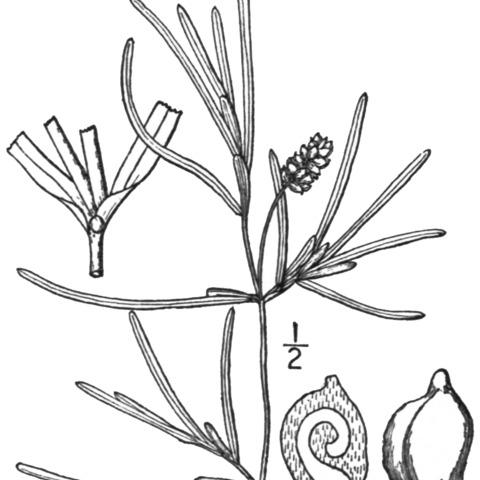Stems very slender, to 1 m, much branched, commonly with paired glands at the nodes; rhizome scarcely developed; lvs all submersed, often suffused with red, linear, 3–10 cm × 1–3.5 mm, obtuse or rounded (sometimes minutely cuspidate) at the tip, the lateral veins 2(4), very delicate, the midvein flanked by 1–4 rows of lacunar cells on each side; stipular sheaths axillary, free, 1–2 cm, very thin and scarious, the margins merely overlapping; winter-buds commonly produced, 3.5–8 cm, but the lvs not strongly differentiated; peduncles axillary, 1–2(–4) cm; spikes 8–15 mm, thick-cylindric, with mostly 3 closely set whorls of fls; body of the fr obovoid, slightly compressed, with or without a low dorsal ridge-keel, 2.5–3.5 mm, the beak 0.6–0.7 mm; 2n=26. In ponds and streams; Que. and N.S. to Mackenzie R. and B.C., s. to n. N.J., Minn., and Wyo.
Plants annual, submerged in fresh water. Rhizome absent, filiform. Stems ca. 0.8 mm in diam., slightly compressed and creeping at base, richly branched; a pair of nodal glands conspicuously present; turions terminal on axillary branches. Stipules axillary, free, 1-1.8 cm × 1.1-3.5 mm, convolute, membranous to herbaceous, often fibrous-persistent; leaves sessile, linear, 3-6 cm × 2.1-3.5 mm, 3(-5)-veined, lateral veins faint but visible, with narrow to broad rows of lacunae bordering obvious midvein, base narrowly cuneate, apex obtuse to rounded, indistinctly mucronate. Spikes in 2 or 3 whorls of opposite flowers, contiguous, broadly cylindric; peduncles 0.4-1.2 × length of fruiting spike. Carpels (3 or)4(or 5). Fruit obliquely obovoid, 2.6-3.6 mm, with a sharp abaxial keel distinct or indistinct. Fl. and fr. Jun-Oct. 2n = 26.


